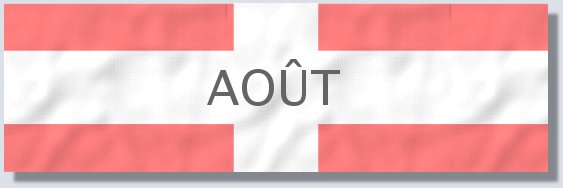|
Although my wife stayed in the Savoie
a few days before we went to Italy on vacation, August brought
my first true visitors. My parents took the train down from
Germany, and after four connections, finally made it to
Aix-les-Bains for four days. As it was a national holiday
on the 15th, I was able to accompany them to a few places
during the long weekend.
|
|
|
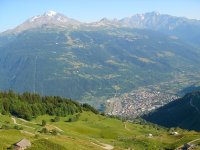
High in the Beaufortain mountains.
|
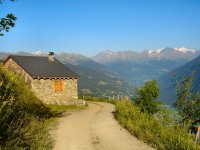
A chalet along our route.
|
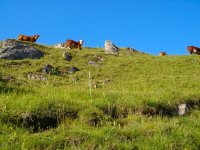
The locals were no help.
|
|
|
Prior to our departure for Italy,
J and I found ourselves with a gorgeous Sunday to exploit.
I had discovered a stunning picture of a nearby citadel
in one of my many guidebooks and decided that it was within
our range of capabilities to ascend the mountain on which
it was perched. So early in the morning, we stuffed a couple
bottles of water in our backpack and headed to the Beaufortain
region near the town of Bourg Saint Maurice to begin our
assault. Eventually, we found the tiny road that climbed
from the village up toward our objective. The road narrowed
significantly to the point where it was essentially a one
way road. At about 3000 ft above the town below, I began
to get a little nervous about encountering cars coming the
other way, so we parked our trusty voiture where
the paved road ended and ventured out on foot.
We walked up the moderate incline for about an hour and
could see the noticeable progress, but we still had no sight
of the fort. After another hour, we not only began to get
tired, but started to doubt the route we had taken. We agreed
to go for another half hour and then turn back if we didn’t
reach the fort. So after two and half hours of incessant
uphill-walking, we agreed to head back down in defeat. There
were considerable accusations and finger-pointing, but I
won’t dwell on the negative. Suffice it to say that some
poor judgment and map reading led to the whole fiasco. Nevertheless,
we had a challenging hike with some exhilarating views of
the French Alps.
On the drive down, we passed a sign
indicating the turn we had missed that would have led us
to the fort on the neighboring mountain. I vowed to return
at all costs and see that fort.
|
|
|
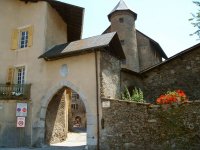
The Porte de Savoie leading into Conflans.
|
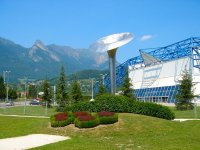
The former Olympic flame at Albertville.
|
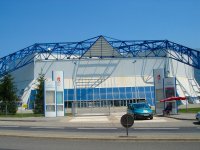
Albertville Olympic skating center.
|
|
|
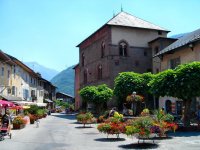
The main square in Conflans.
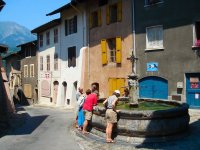
Fountain in medieval Conflans.
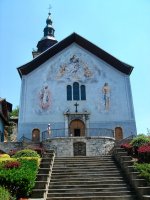
The baroque church of St. Grat.
|
One of the first things that comes
to mind when thinking of the Savoie should be the Olympics.
The region is renowned for its skiing areas and has played
host to three Winter Olympic Games – the inaugural Winter
Games in Chamonix (1924), Grenoble (1968), and most recently
Albertville (1992). In fact, the next Olympics this coming
February is set for Turin, a former capital of the Savoie.
As it were, the wife and I decided
to visit Albertville to check one more former Olympic host
city off of our list. My friend had described Albertville
as this: Before the Olympics it was a small town, during
the Olympics it was a big town, and after the Olympics it
is a small town again. This turns out to be a pretty
accurate description. One characteristic of the Winter Games
is that the majority of the competitions don’t actually
take place in the host city but rather in the surrounding
mountain villages. So our visit to Albertville yielded only
a view of the Olympic stadium and skating venues.
But Albertville possesses another
little jewel in the form of a medieval town perched above
the Olympic city. Conflans, its name derived from its location
at the confluence of the Isère and Arly rivers, thrived
as a stop along the trade route through the Alps between
Milan and Vienne. The Hospitallers of St. John of Jerusalem
(also known as the Knights of Malta) built a hostelry here
to shelter pilgrims and eventually crusaders en route to
the Holy Land. Today the town hosts only tourists as most
of the buildings are shops, galleries, and artist workshops,
but it still retains the charm of a walled city from the
middle ages.
|
|
|
|
Eager to have a relaxing Sunday,
we took a boat ride to the western shore of the Lac du Bourget
to visit Hautecombe Abbey. Built during the 12th century,
the abbey was first Cistercian and then Benedictine. Today
it is owned and operated by the Chemin Neuf (new way), a
Catholic youth organization. The abbey is most famous for
being the primary burial site of the House of Savoie. Altogether
there are over forty members of Savoie royalty interred
in the abbey, including the last King of Italy Umberto II
who was laid to rest in 1983. The last burial took place
in 2001 for Umberto’s wife Marie-José, the Princess
of Belgium and Queen of Italy.
The abbey is relatively small, and
the tours are structured so that you must proceed through
the abbey as a group. Handheld recorded guides were available
in English to lead us through the abbey. The tour was done
in stages so that the part of the abbey being discussed
by the guides would light up, followed by the next part
and so on. My guide was about 30 seconds behind everyone
else’s, so when I got to each stage the lights would go
out and the next stage was illuminated. So there I was,
stage after stage, constantly standing in the dark looking
at some painting or sculpture and listening to my tour-phone.
|
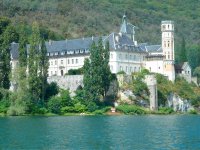
L'Abbaye d'Hautecombe on the banks
of Lac du Bourget.
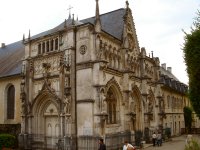
Entrance to the abbey.
|
|
|
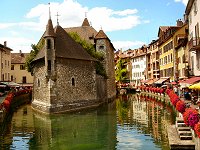
Palais de l'Isle.
|
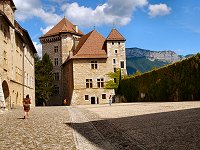
The 12th century château in Annecy.
|
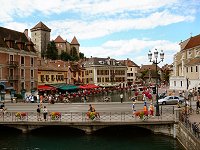
The Thiou canal partitions the old
town.
|
|
|
At the northern tip of Lac d’Annecy,
one finds the beautiful capital of the Haute Savoie named
– you guessed it – Annecy. Along with Chamonix, it is one
of the two most popular tourist attractions in the Savoie
region. Built along a main trade route between Italy and
Geneva, the town has everything you need – a port, a beach,
a vielle ville with cobblestone streets and arcades,
a cathedral, canals, several large parks, and a château
looking down on it all. It is also known for flowers; in
fact it won the national Ville Feurie (flowered city)
competition so many times that it was banned from participating
in the event.
The river Thiou segments the city
and forms its main canal that for 150 years turned the mills
which produced cotton fabrics. Situated in the middle the
canal is the ship-shaped Palais de l’Isle, surely Annecy’s
most photographed structure. Since the 12th century, this
multifunctional building has served as the residence of
the de l’Isle family, hosted numerous government facilities,
functioned as a prison, and today hosts Annecy’s museum
of history. It was also part of the only bridge across the
Thiou and controlled passage along the main trade route
leading through the city.
Prior to our tour of the city, my
parents and I took advantage of the apparently clearing
skies to enjoy a cruise around the lake. The two-hour circuit
took us past small lakeside towns with mountain backdrops
like Sévrier, home of the Paccard bell foundry, whose
bells can be found in Sacré Coeur, the Cathedral
of Rouen, and St. Patrick's Cathedral in New York. We saw
the grand belle époque Palace de Menthon hotel as
well as Château de Menthon Saint Bernard, the birthplace
of St. Bernard, and Château de Duingt, subject of
Cezanne’s painting of Lac d’Annecy.
|
|
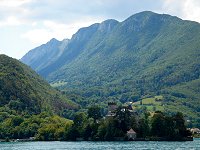
Château de Duingt.
|
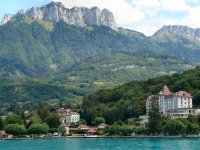
The Palace de Menthon hotel.
|
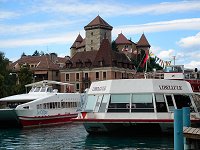
Our cruise ship, the Libellule.
|
|
|
| 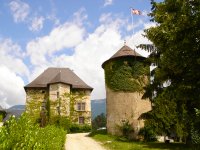
Château Candie in Chambéry-le-Vieux.
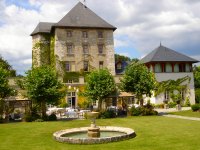
The gardens and outside dining area.
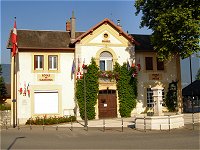
The town hall of Chambéry-le-Vieux
which was once a boys school and a girls school - separated
of course.
|
The weekend my folks came to visit
was close to their 47th wedding anniversary, so my father
wanted us all to go out for a fancy meal. I had asked around
at work and one of the places that kept coming up was the
Château Candie in nearby Chambéry-le-Vieux.
Well, eating at a château sounded fancy enough and,
upon hearing my choice, my friend made that kissing sound
of approval with his thumb and two fingers that only the
French can do, so I made reservations for lunch.
Now there are many things to get
used to about eating out in France, but one key thing to
understand is the menu. I’m not just talking about the seemingly
hundreds of words that the French use to describe a single
cut of meat or the fact entrées actually refer
to appetizers. To survive, one must understand the concept
of the ménu. A ménu is a set
meal sequence, usually 3 to 5 courses with two to three
options for each course. Often, these are pretty good deals
and offer items that the chef made fresh that day, or conversely,
he needs to get rid of. Your alternative is to order from
the menu (or carte) in which case you will only receive
that dish with no extras – hence the expression à
la carte. Château Candie has two pricey ménus
and a third that is simply called Chef’s Surprise. I’d had
my fill of gastronomic surprises during my time in France,
and I didn’t want to spend a fortune building a meal from
items à la carte, so I opted for the cheapest
ménu mainly because it contained the fewest number
of courses.
Long story short (if that’s still
possible at this point) - they fed me a pigeon. Not a whole
one, but just a breast and a scrawny leg (probably because
they do a lot of walking). Here’s something most people
don’t know: pigeon is red meat. It was cooked a little rare
but tasted just like steak. If word gets out, New York could
be the next culinary capital.
Meanwhile, the waves of food kept
coming, even things we didn’t order but were included in
the bargain like a liver cappuccino (that’s right – a liver
cappuccino), melon soup, and shrimp jello. When the dust
settled, my father’s wallet was significantly lighter, and
I would never look at a pigeon the same way again – or a
cappuccino for that matter.
|
|
|
